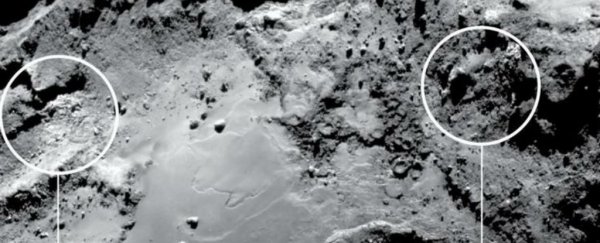For the first time, scientists have confirmed the existence of large patches of water ice on the surface of a comet, saying it's likely formed a dry, crunchy coating over an ice-layered core of the iconic comet called 67P/Churyumov-Gerasimenko. The discovery solves a months-long mystery over why water has been identified everywhere else on the comet except its surface.
"First, not finding ice was a surprise; now, finding it is a surprise," one of the team, planetary scientist Murthy Gudipati from NASA's Jet Propulsion Laboratory, told Deborah Netburn at the Los Angeles Times. "It is exciting because now we are starting to understand the upper dynamic layers of the comet and how they evolved."
Back in 2014, 67P/Churyumov-Gerasimenko unwittingly made history by being the first comet to be landed upon by a remotely operated spacecraft - the plucky little spacecraft called Philae whose imminent demise was announced earlier this week.
With the help of Philae and its partner probe, Rosetta, scientists have since identified a vast nebulous cloud of gas surrounding the comet - called a coma - which they found to be mostly made up on water molecules. They also found enough evidence to suggest that water ice is one of the main components of the comet's nucleus - the solid, centrally located part of a comet, also known as its 'dirty snowball'.
But oddly enough, despite finding water in and around the comet, there were no signs of water ice on the actual surface. Until now.
Reporting in Nature this week, Gudipati and his colleagues describe how they identified patches of water ice in a dusty region at the bottom of the comet's nucleus, called Imhotep. They did this by getting the Rosetta spacecraft to shine infrared light on the surface, and analysing the different types of reflections that bounced back.
Using the VIRTIS-M instrument onboard the Rosetta spacecraft to investigate the reflections, they've identified two different types of water ice on the surface - millimetre-sized pure water-ice grains, and 50-micrometre-sized grains.
"The small grains that are in the micrometre range are likely associated with a thin layer of frost that forms as a function of the comet's rotation," says Netburn. "As this region of the comet turns away from the Sun, water ice condenses out of the coma and onto the nucleus, the authors wrote. During the 'day', the water goes back into the coma."
The history of the larger ice grains, she adds, appears to be a lot more complex. The researchers suspect that it might vapourise every time the comet draws close to the Sun, and then condense back into the tiny void spaces in the lower surface regions as the comet draws away and cools.
"Keep in mind that comets are very porous, like cotton candy," Gudipati said. "Seventy percent of this comet is a void, and because of that, the heat from the surface does not go that deep."
The team will now analyse data collected at periods in time to see how the water ice responded to the comet drawing closer to the Sun in mid-2015.
"Understanding which features on the comet are left over from its formation and which have been created during its evolution is somewhat challenging, one of the team, Matt Taylor, told Astronomy Magazine, "but this is why we are studying a comet up close: to try to discover what processes are important at different stages of a comet's lifetime."
